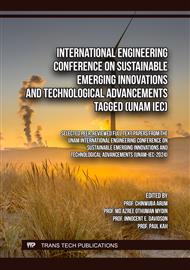[1]
F. S. dos Santos, K. K. F. do Nascimento, J. da Silva Jale, S. F. A. Xavier, and T. A. E. Ferreira, "Brazilian wind energy generation potential using mixtures of Weibull distributions," Renew. Sustain. Energy Rev., vol. 189, p.113990, 2024.
DOI: 10.1016/j.rser.2023.113990
Google Scholar
[2]
A. A. Attabo, O. O. Ajayi, S. O. Oyedepo, and S. A. Afolalu, "Assessment of the wind energy potential and economic viability of selected sites along Nigeria's coastal and offshore locations," Front. Energy Res., vol. 11, p.1–15, July 2023.
DOI: 10.3389/fenrg.2023.1186095
Google Scholar
[3]
K. S. R. Murthy and O. P. Rahi, "A comprehensive review of wind resource assessment," Renew. Sustain. Energy Rev., vol. 72, p.1320–1342, 2017.
DOI: 10.1016/j.rser.2016.10.038
Google Scholar
[4]
S. Jung, O. Arda Vanli, and S. D. Kwon, "Wind energy potential assessment considering the uncertainties due to limited data," Appl. Energy, vol. 102, p.1492–1503, 2013.
DOI: 10.1016/j.apenergy.2012.09.011
Google Scholar
[5]
M. Shoaib, I. Siddiqui, S. Rehman, S. Khan, and L. M. Alhems, "Assessment of wind energy potential using wind energy conversion system," J. Clean. Prod., vol. 216, p.346–360, 2019.
DOI: 10.1016/j.jclepro.2019.01.128
Google Scholar
[6]
M. Wadi and W. Elmasry, "Statistical analysis of wind energy potential using different estimation methods for Weibull parameters: a case study," Electr. Eng., vol. 103, no. 6, p.2573–2594, 2021.
DOI: 10.1007/s00202-021-01254-0
Google Scholar
[7]
N. L. Panwar, S. C. Kaushik, and S. Kothari, "Role of renewable energy sources in environmental protection: A review," Renew. Sustain. Energy Rev., vol. 15, no. 3, p.1513–1524, 2011.
DOI: 10.1016/j.rser.2010.11.037
Google Scholar
[8]
A. G. Olabi et al., "Selection Guidelines for Wind Energy Technologies," Energies 2021, 14(11), 3244;.
DOI: 10.3390/en14113244
Google Scholar
[9]
H. Shi, Z. Dong, N. Xiao, and Q. Huang, "Wind Speed Distributions Used in Wind Energy Assessment: A Review," Frontiers in Energy Research, 9, 769920, 2021
DOI: 10.3389/fenrg.2021.769920
Google Scholar
[10]
B. Adem Çakmakçı and E. Hüner, "Evaluation of wind energy potential: a case study," Energy Sources, Part A Recover. Util. Environ. Eff., vol. 44, no. 1, p.834–852, 2022.
DOI: 10.1080/15567036.2020.1811810
Google Scholar
[11]
S. A. Vargas, G. R. T. Esteves, P. M. Maçaira, B. Q. Bastos, F. L. Cyrino Oliveira, and R. C. Souza, "Wind power generation: A review and a research agenda," J. Clean. Prod., vol. 218, p.850–870, 2019.
DOI: 10.1016/j.jclepro.2019.02.015
Google Scholar
[12]
A. N. Celik, "A statistical analysis of wind power density based on the Weibull and Rayleigh models at the southern region of Turkey," Renew. Energy, vol. 29, no. 4, p.593–604, Apr. 2004.
DOI: 10.1016/J.RENENE.2003.07.002
Google Scholar
[13]
A.M. Muzathik, M.Z. Ibrahim, K.B. Samo, R. Zailan, and W.B. Wan Nik, "Wind Characterization for Renewable Energy Applications," Universiti Tenaga Nasional Journal of Energy & Environment. Vol.3, no. 1, 12-17, 2011.
Google Scholar
[14]
F. I. Abam and O. S. Ohunakin, "Applications of small-scale, stand-alone wind energy conversion systems in rural Cross River State, Nigeria," African J. Sci. Technol. Innov. Dev., vol. 10, no. 5, p.539–550, 2018.
DOI: 10.1080/20421338.2017.1366134
Google Scholar
[15]
A. K. Azad, M. G. Rasul, M. M. Alam, S. M. Ameer Uddin, and S. K. Mondal, "Analysis of wind energy conversion system using Weibull distribution," Procedia Eng., vol. 90, p.725–732, 2014.
DOI: 10.1016/j.proeng.2014.11.803
Google Scholar
[16]
S. Perkin, D. Garrett, and P. Jensson, "Optimal wind turbine selection methodology: A case-study for Búrfell, Iceland," Renew. Energy, 75 (2015) 165–172
DOI: 10.1016/j.renene.2014.09.043
Google Scholar
[17]
P. Quan and T. Leephakpreeda, "Assessment of wind energy potential for selecting wind turbines: An application to Thailand," Sustain. Energy Technol. Assessments, vol. 11, p.17–26, 2015.
DOI: 10.1016/j.seta.2015.05.002
Google Scholar
[18]
H. Mohamadi, A. Saeedi, Z. Firoozi, S. Sepasi Zangabadi, and S. Veisi, "Assessment of wind energy potential and economic evaluation of four wind turbine models for the east of Iran," Heliyon, vol. 7, no. 6, p. e07234, 2021.
DOI: 10.1016/j.heliyon.2021.e07234
Google Scholar
[19]
K. Wolniewicz, "Analysis of the Wind Turbine Selection for the Given Wind Conditions," Energies 14(22) (2021) 7740;.
DOI: 10.3390/en14227740
Google Scholar
[20]
US Environmental Protection Agency https://www3.epa.gov/ttnchie1/conference/ei20/ session5/mmittal.pdf
Google Scholar


